AES New York 2018
Engineering Brief EB02
EB02 - Live Sound, Recording, and Production
Friday, October 19, 9:00 am — 10:00 am (1E10)
Chair:
Paul Geluso, New York University - New York, NY, USA
EB02-1 Loudness Metering in Sound Reinforcement: Utilities and Practical Considerations—Cristian Eduardo Becerra Benítez, Universidad Tecnologica de Chile INACAP - Santiago de Chile, Chile; SABE Sonido
Loudness meters were created to standardize levels in broadcasting (radio and TV), to minimize differences between program level and commercial level. This standard is already used in several countries, but will it be useful for live sound? Will it allow for better mixing results in sound reinforcement situations? The following Engineering Brief aims to answer these questions and provide some considerations for loudness meters use in sound reinforcement.
Engineering Brief 458 (Download now)
EB02-2 Streamlined 3D Sound Design: The Capture and Composition of a Sound Field—Wieslaw Woszczyk, McGill University - Montreal, QC, Canada; Paul Geluso, New York University - New York, NY, USA
A pragmatic approach to 3D sound design is described that employs a minimum number of sound fields captured with tetrahedral microphones. The captured sound fields, each extended in a horizontal and vertical dimension, are combined to provide the essential segments of the entire 360° sound design. Supplemental single-capsule microphones are used as needed for balancing of spaciousness and clarity. A compatible scaling of sound design from 3D to 2D can be easily accomplished without distortion of timbre or space.
Engineering Brief 459 (Download now)
EB02-3 Interactive Recorded Music: Past, Present, and Future—Justin Paterson, London College of Music, University of West London - London, UK; Rob Toulson, University of Westminster - London, UK
This Engineering Brief charts the story of user-interactivity with recorded music. Audio technologies and creative compositional techniques are discussed with particular regard to scenarios where creativity has driven the demand for technological advance, and vice-versa, where technical advance has enabled new creative-practice approaches. This is contextualized through discussion of relevant implementation in legacy systems, mobile applications, video games, artificial intelligence, and extended realities. In identifying seminal applications of music interactivity from the past and linking them to present capabilities and practices, future trajectories for interactive recorded-music are extrapolated.
Engineering Brief 460 (Download now)
EB02-4 Producing Audio Drama Content for an Array of Orchestrated Personal Devices—Jon Francombe, BBC Research and Development - Salford, UK; James Woodcock, University of Salford - Salford, Greater Manchester, UK; Richard J. Hughes, University of Salford - Salford, Greater Manchester, UK; Kristian Hentschel, BBC Research and Development - Salford, UK; Eloise Whitmore, Naked Productions - Manchester, UK; Tony Churnside, Naked Productions - Manchester, UK
Personal devices with loudspeakers can be orchestrated to increase immersion from low channel count reproduction systems. A trial production was conducted to investigate the content creation work?ow and delivery mechanism for orchestrated devices. The content (a 13-minute science-?ction drama entitled “The Vostok-K Incident”) included: a stereo bed; elements only replayed from auxiliary devices; and elements that could either be in the stereo bed or replayed from auxiliary devices. A bespoke production environment was established, including plug-ins for authoring the metadata needed to utilize the rendering ruleset. Ambiguity in the reproduction system, coupled with ?exible and complex metadata authoring requirements, made the production challenging and time-consuming. Future work will focus on re?ning the production process and developing delivery tools.
Engineering Brief 461 (Download now)
